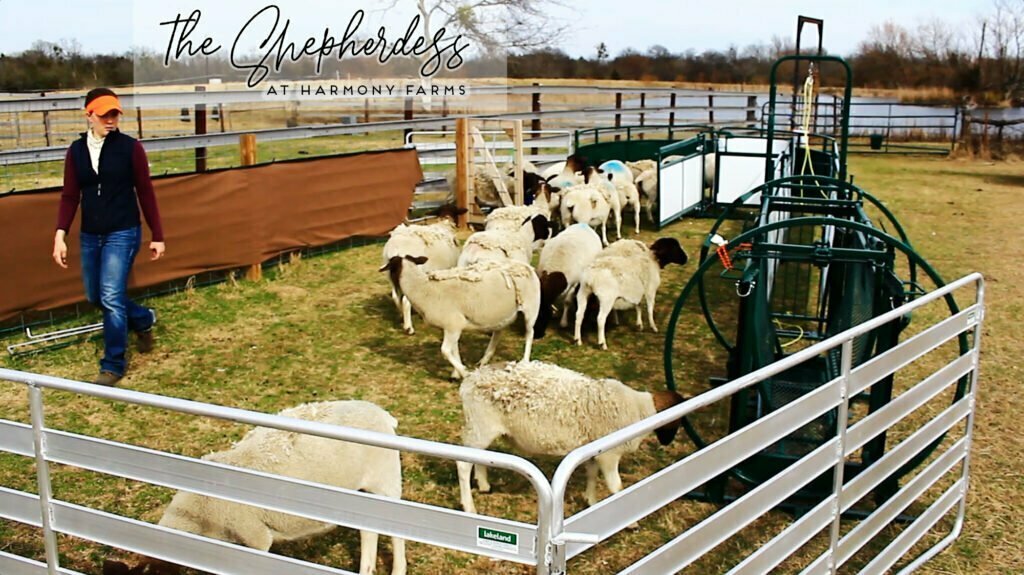In the sheep arena there are 3 hair breeds that are both well developed and well known in the USA: the Dorper Sheep, the Kathadin sheep, and the St. Croix sheep. Today I am going to talk about why I raise Dorper sheep instead of St. Croix sheep, despite the fact that St. Croix would seem to be a better fit for my climate.
Download my free e-book for beginner sheep farmers!
Of the three breeds I just mentioned, St. Croix boasts the highest level of parasite resistance and the Dorper sheep the lowest, with the Kathadin sheep falling somewhere in the middle. Being that internal parasites are one of the top 3 profit killers for sheep farmers (right above predators and hoof rot) it is presumable that, as a farmer in a highly parasite prone environment, I would choose the breed that struggles the least with parasites.
But there are 2 major reasons why St. Croix is not a good fit for my goals, and I am going to outline them in the upcoming video.
First off what are my goal?: Goal #1 is to convert my grass resource into a highly desirable finished product. I am raising pure Dorper stock with an emphasis on a high carcass yield. “Carcass yield” refers to sale-able meat that comes off the animal.
Which brings me to the first reason I do not raise St. Croix sheep.
The carcass weight on a pure St. Croix sheep is not suitable for commercial
(meat sales) production.
When it comes to sheep, meat market buyers want lambs to weigh 100 lbs before slaughter and they want the lambs to reach this weight by 6-8 months.
A mature Dorper ram tops out at 270lbs and a mature St. Croix ram tops out at 170lbs. These are top weights for each breed, meaning you can deduct 30-50lbs for rams on the low end. Within a standard grazing program a ram will reach half of its mature weight by 12 months. Using grain or a highly specialized pasture-finishing program, half mature weight can easily be achieved by 6-8 months.
On an expedited finishing program a pure Dorper lamb will reach 135lbs and a pure St. Croix lamb 85 lbs (or 115 and 60lbs on the low end).
This means that a pure St. Croix, even at its best, will not reach an adequate finishing weight within the industry standard 6-8 months, whereas a pure Dorper (even at its worst) will. When it comes to Dorper sheep, they are literally born with muscles built in. These are photos of newborn, 3 week old, and 10 week old lambs from my farm this year.
But this information is not based solely on personal evaluation. I interviewed two for-profit farmers, Luke Groce and Austin Troyer, both of which started a sheep operation with the St. Croix as their foundation: Luke Groce cited that the carcass yield on a St. Croix was not enough to justify labor inputs. Austin Troyer, who purchased his seed stock from Greg Judy at Green Pastures Farms, cited that he could not sell commercial meat buyers on a pure St. Croix carcass. The former removed sheep from his meat sales program and the latter introduced Dorper bloodlines to improve his existing St. Croix flock.
The second reason I chose Dorper over St. Croix is desirability. Demand for Dorper breed, and specifically the black head Dorper, is experiencing an unprecedented surge here in the USA. Sales at the 2022 mid America Dorper Show nearly broke $1 MILLION with the top Dorper ewe bringing $20,000 and ram $12,800. https://dorpersheep.org/newsite/wp-content/uploads/2022/04/2022-Mid-America-Dorper-Sale-Report-1.pdf?fs=e&s=cl
This level of notoriety makes the Dorper sheep incredibly marketable.
To approach this from strictly in numbers perspective, the St. Croix is 37% smaller than the Dorper sheep. When it comes to making a living off of livestock, 7/10 ranchers are selling based on a liveweight price. This means if you have 37% less liveweight in an animal, you have 37% less income. And to double back to industry standards, meat buyers will be naturally avoiding animals with small carcasses. This means that in a conventional market, you will likely see more than a 37% percent decrease in the price received for St. Croix lamb.
This is not to say that the breed does not have it’s place. Pure St. Croix are a great fit for homesteaders and entry level sheep farmers, but if you are going into a hard core ranching for profit situation, you will need to cross your St. Croix with a larger breed (like the Dorper) to bring your carcass size up to market standards.
But just how much time does it take to manage a more parasite susceptible breed in a highly parasite prone climate? No matter how valuable a Dorper sheep is, it’s worthless if it dies of worms. How long does it take me to keep parasites under control in my system?
Once a month I run the flock through my Lakeland Handling system for general health maintenance. During this time I FAMACHA score and deworm any sheep that needs it. For my flock of 48 sheep, this process takes 4 hours per month, or 48 hours per year. This breaks down to just 1 hour per sheep per year in health and parasite management. Because most of the time is spent getting the sheep to and from the pen for treatment, and not actually treating the sheep, this timer per sheep will only decrease as my flock size increases.
To be honest, every breed has it’s pros and cons, and Dorper vs. St Croix is not different. The St Croix is very parasite resistant, the Dorper is not. The Dorper is extremely desirable in the conventional market, the St. Croix is not. With my goals in mind, spending 1 hour per animal per year to manage parasites is a much smaller con than a 37% (or more) decrease in income potential per animal.
Another important thing to note is that if you are running St. Croix just so you never have to deworm, you may be disappointed. As you watch Greg Judy keep in mind that he grazes his flock across several hundred acres of pasture. His stocking rate is roughly 1 sheep to 2 acres. If you are like me and are running 2 sheep to 1 acre, the parasite load on your pasture is going to be heavier.
Another topic I want to address is cross-breeding for increased parasite resistance. Cross Breeding is a great option, but it is not one I am considering yet. Pure Dorper offers too many advantages right now to deviate and I am extremely pleased with the product so far. What’s more is that with my parasite management down my losses are little to none. Last year I lost only one sheep to the Barber Pole Worm over summer, this year I have lost none. And with each successive generation born on farm I am seeing more and more natural parasite resistance. We are approaching the 4th generation born in my moist and humid micro-climate and I believe parasite resistance within my Dorper flock will keep getting better and better.
-the Shepherdess
“But they that wait upon the Lord shall renew their strength; they shall mount up with wings as eagles; they shall run, and not be weary; and they shall walk, and not faint.” Isaiah 40:31


Good thoughtful and informative analysis.
In your context and with your goals it does seem that the Dorper breed is a good fit and that the Lord is blessing you with a strong and healthy flock. I appreciated the way you pointed out that St. Croix is a good breed for homesteaders and entry level sheep farmers. Helpful information for those getting started, and the process of analysis you used can help others when considering their own context and goals.
Keep up the good work!
I really appreciate the time you invest in these informative newsletters. I had not realized there was such a size difference between those two breeds. And your point on managing a potential weakness rather than ignoring it is really spot on.
This is a great comparison as someone who is looking into what breed of sheep to get this is very helpful.
Thankyou.
I want to Thank You for your knowledge of Dorper Sheep. You have made my mind up, I have decided that when I buy my Land I’m going to raise the Dorper Sheep instead of St, Croix. I really appreciate your knowledge. Gods Blessings for you. Jerry M
Great analysis and explanation.. thank you!
I am quite proud to say that since South Africa is not the easiest part of the world to raise sheep, the stockmen of SA have made huge strides in the small stock industry. I dare to say, we have made bigger strides than Aus or NZ.
I name the following South African breeds:
1. Dohne merino
2. Dorper
3. Boer goat
4. SA meat merino
5. Dormer
6. Meatmaster
Even the FAMACHA system is named after Prof Faffa Malan.
Few know it, but the first merino in Aus came from SA.
The biggest profit killer in South Africa, ranked above Predators, Wireworm (haemonchus contortus), flystrike and footrot is, MAN. Stocktheft is our biggest problem.
As far as parasite resistance is concerned, the Wauldby Dohne Merino stud of Robbie Blaine, are the world leaders in parasite resistance. 15 years of fortnightly Fecal Egg Count, Famacha, body score of every stud ewe in a 500 herd group have lead to the most scientific barber pole worm resistance program to date.
Read Joel Salatin books about moving livestock everyday and follow them about four days behind with chickens who manage the pests.
By moving the sheep daily, they do not stay around their own feces and are not exposed to the pests from their feces.
After about four days ago the feces starts producing insect larvae, which the chickens will eat. They will also spread the manure around on the fields, fertilizing it as they go.
I know it sounds like a lot of work, but you can put several sheep on one fresh acre everyday, with a moves le electric fence. Since you are moving them daily, they do not run out of food and they do not get pests and disease from stomping around in their own feces.
Thanks, Donna! I love Salatin’s methods and practice them at my farm.
we are breeding St Croix and Doper sheep and having very much success I have noticed that we are having to worm a little more but my sheep run on lots of pasture the weight on the babies are outstanding